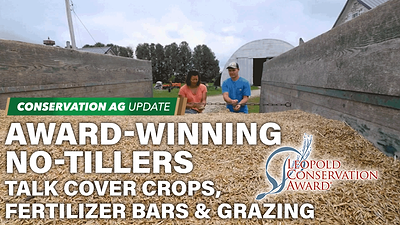Iowa farmer Seth Watkins is blazing the trail with a new conservation practice to reduce soil loss and improve water quality: seeding strips of native prairie into cropland on his farm.
Planting prairie strips in row-cropped fields is a conservation approach pioneered by the Science-based Trials of Rowcrops Integrated with Prairies (STRIPs) Research Team at Iowa State University. Watkins seeded eight acres in a 50-acre field with prairie on June 27, becoming one of the first Iowa farmers to adopt this practice.
“Adoption of research is what we’ve been investing in and waiting for,” said Jeri Neal, leader of the Leopold Center for Sustainable Agriculture Ecology Initiative that provided initial funding for the STRIPs project in 2002. “We have some practices that make an enormous difference. How can we get them on the ground?”
Watkins runs a 600-head cow-calf operation and grows corn, soybean and alfalfa on 2,800 acres of land that he owns, rents or manages for pasture in Taylor County, Iowa. He invited members of the STRIPs Research Team to visit his operation last summer to hear their advice about how to plant prairie strips on the land under his care. Doug Davenport, a Natural Resources Conservation Service (NRCS) district conservationist, arranged the collaboration.
Davenport called the prairie strips “a new opportunity” for farmers. “We’ve never had the best land use be something people could actually make a living doing,” he said.
Research conducted by the STRIPs team at the Neal Smith National Wildlife Refuge showed that planting 10 to 20 percent of a watershed in native prairie reduces the amount of sediment leaving the watershed by more than 90 percent. Nitrate and phosphorus movement also decreases, protecting the quality of nearby waterways.
The deep roots and stiff, upright stems of native prairie plants slow surface runoff and hold soil in place more effectively than cool-season plantings such as brome, and also create better wildlife habitat. Even small patches of prairie have the potential to greatly improve a farm’s resilience to extreme climatic events, such as heavy rainfall and flooding.
On the hilly farmland where Watkins seeded prairie strips, deep ruts and an algae-choked pond showed evidence of erosion and runoff from very wet spring weather. “My hope is that if the strips work as well as I believe the ruts will go away and the pond will be clear again,” he said.
Matt Liebman, ISU agronomy professor, said he expects it will take roughly three years for the newly seeded prairie to take root. “Prairie plants spend their first few years putting more roots in the ground than shoots in the air,” he said. “You have to control weed competition, typically by mowing in the first year or two.” Landowners also have the opportunity to harvest the prairie strips for bedding or hay, unless they have enrolled the land in federal cost-sharing agreements.
STRIPs researchers will help Watkins monitor the effect of the new prairie strips on soil, water and wildlife. “My gut tells me it’s a good practice,” Watkins said. “If other people are going to buy in, they’re going to need some hard data.”
Landowners who would like to learn more about planting prairie strips can contact the NRCS for technical and financial help by asking for the “contour buffer strip standard” for hillsides and the “filter strip standard” for foot slope positions.
The STRIPs project has been supported by the Leopold Center, Iowa State University, Neal Smith National Wildlife Refuge, U.S. Fish and Wildlife Service, Iowa Department of Agriculture and Land Stewardship, U.S. Department of Agriculture, U.S. Forest Service, and National Science Foundation.





